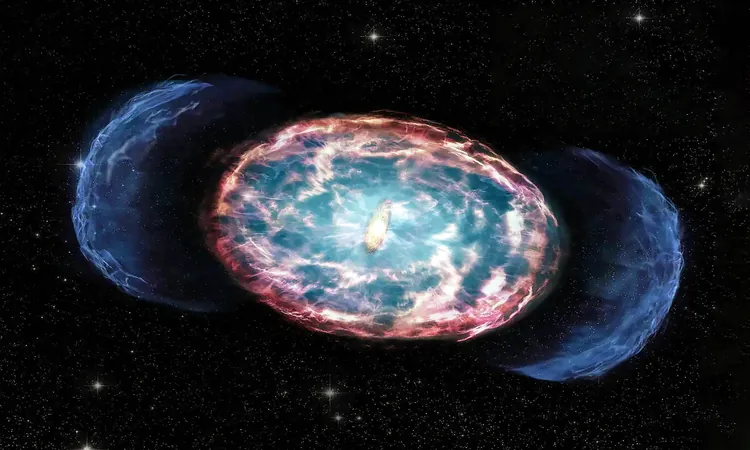
The Dangers Looming from Neutron Star Collisions: What You Need to Know!
2025-04-06
Author: Kai
Unpacking Neutron Stars
Neutron stars are the remnants of massive stars that have undergone supernova explosions. When such a giant star depletes its nuclear fuel, it collapses under its own gravity. The outer layers explode, while the core becomes so densely packed that protons and electrons merge to form neutrons. This results in a stellar object no larger than a city but more massive than our Sun! A mere teaspoon of neutron star material would weigh about a billion tons.
These small yet mighty stars exhibit fascinating characteristics, including rapid rotation, which causes them to emit beams of radiation akin to cosmic lighthouses, known as pulsars. In some cases, they can become magnetars, boasting the strongest magnetic fields in the universe. Despite their distance, neutron stars provide critical insight into the fundamental principles of physics and matter under extreme conditions.
The Kilonova Explosion: What Happens When They Merge?
When two neutron stars merge, the collision triggers a kilonova, an event that releases tremendous bursts of gamma rays and X-rays. This radiation poses a serious threat to any nearby planets by stripping away their protective atmospheric layers. The intense ionizing radiation can compromise the ozone layer, allowing harmful solar ultraviolet rays to penetrate the surface and endanger living organisms.
Delving into the danger posed by nearby kilonovae, experts emphasize that the energy released can accumulate over time, potentially reaching levels that significantly weaken a planet's atmospheric defenses against solar radiation.
Understanding the Risks: Gamma Rays and Cosmic Rays
While short bursts of gamma rays from such collisions have garnered attention, scientists are now focusing on the less obvious threat of cosmic rays that follow. Even if a planet is not directly in the path of the initial beam, scattered emissions can still have measurable effects. Observations from the event GW170817 have shown that off-axis planets can detect harmful radiation, indicating that harm could extend beyond the immediate vicinity of the explosion.
Both gamma rays and the subsequent cosmic rays generated by the collision can create reactive molecules in the atmosphere, further degrading its protective capabilities. There is growing concern among researchers about the long-term biological risks associated with cosmic rays, which may even lead to genetic mutations in living organisms.
Cosmic Catastrophe: Frequency and Impact
Fortunately for Earth, kilonovae are rare on a cosmic scale, occurring infrequently in our galaxy. The odds of a kilonova happening close enough to Earth to be dangerous are quite slim compared to more frequent supernova events, which have a higher chance of impacting our planet in terms of harmful cosmic rays.
However, scientists caution that even with the low probability, the consequences of a nearby kilonova could be devastating. The possibility of atmospheric ionization could result in short-lived electrical surges capable of overwhelming power grids, causing satellite failures, and creating intense auroras visible even during the daytime. Astronauts beyond Earth’s protective atmosphere would face heightened risks from incoming high-energy particles.
The Future of Kilonova Research
So far, only one kilonova event, GW170817, has been extensively observed, allowing scientists to model potential impacts. As technology advances, astronomers are optimistic about gathering more data on these extraordinary events through both space-based and ground-based observatories.
Future studies will help settle crucial questions regarding the fading time of various emissions and clarifying whether cosmic rays or gamma rays represent the greater threat to life and technology on Earth.
Stay tuned as we continue to uncover the hidden dangers lurking in the universe! The more we learn about kilonova events, the better we can prepare for the unknown challenges they may bring!



 Brasil (PT)
Brasil (PT)
 Canada (EN)
Canada (EN)
 Chile (ES)
Chile (ES)
 Česko (CS)
Česko (CS)
 대한민국 (KO)
대한민국 (KO)
 España (ES)
España (ES)
 France (FR)
France (FR)
 Hong Kong (EN)
Hong Kong (EN)
 Italia (IT)
Italia (IT)
 日本 (JA)
日本 (JA)
 Magyarország (HU)
Magyarország (HU)
 Norge (NO)
Norge (NO)
 Polska (PL)
Polska (PL)
 Schweiz (DE)
Schweiz (DE)
 Singapore (EN)
Singapore (EN)
 Sverige (SV)
Sverige (SV)
 Suomi (FI)
Suomi (FI)
 Türkiye (TR)
Türkiye (TR)
 الإمارات العربية المتحدة (AR)
الإمارات العربية المتحدة (AR)